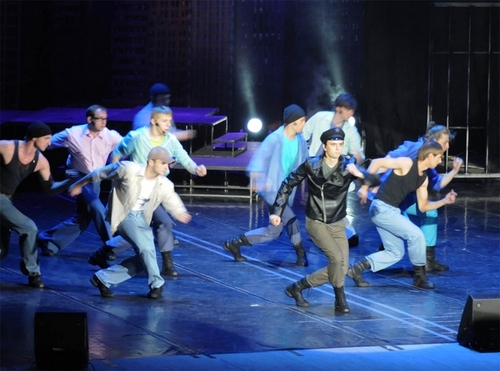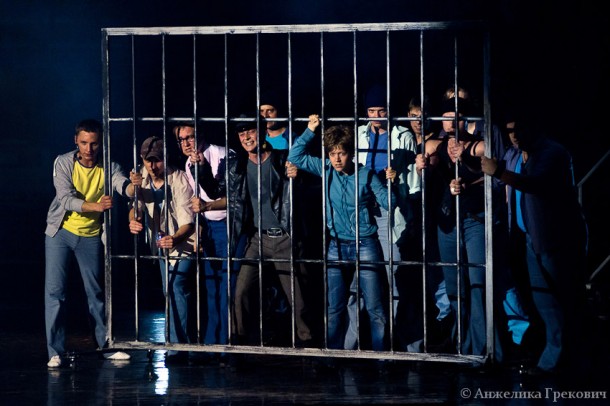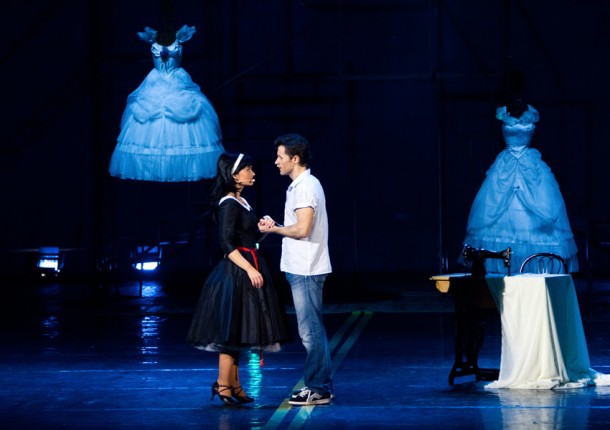The highlight of my trip to Minsk this summer was West Side Story at the Belarus State Musical Theatre (BSMT). Having flown in to see a performance of the show on 27 May 2013, a little over a year after the show’s premiere, I was struck by the freshness the Broadway classic radiates in this Russian-language incarnation.
This first fully-mounted production of West Side Story in Belarus is the result of joint efforts by the BSMT and the US Embassy in Minsk. The two partner organizations assembled an able Belarusian-American creative team: director Anastasia Grinenko (Belarus), choreographers Paul Emerson (USA) and Dmitry Yakubovich (Belarus), conductors Nikolai Makarevich (Belarus) and Philip Simmons (USA), stage designer Andrei Merenkov (Belarus), and costume designer Yulia Babaeva (Belarus). Unlike the musical’s other recent appearance in Russian, at the Globus Theatre in Novosibirsk, the Minsk version is not a transfer of the 1957 Broadway production. While some of the newly-choreographed numbers in the BSMT interpretation are deeply indebted to Jerome Robbins’s original dance lexicon, the overall directorial vision steers clear of imitation, carefully balancing the familiar and the unfamiliar for Belarusian theatre-goers, most of whom have never seen this American musical on stage.
Vladimir Posner’s Russian translation of the book and lyrics is scrupulous, inventive, and at times exquisite. It is no small feat to render the compactly worded lyrics of a US musical into a language notorious for its morphologically and syntactically inflicted long-windedness. Posner’s unflagging commitment to Stephen Sondheim’s ambitious rhyme schemes in songs like “I Feel Pretty” and “America” is uncommon among translators of musical theatre in Belarus and Russia today. His treatment of the spoken dialogue remains as theatrically effective as it was in 1979, when this translation was published in a hardcover edition in the Soviet Union. In converting the language of the Jets into Russian, he takes his cue from the show’s librettist, Arthur Laurents, who consciously eschewed over-reliance on the current slang of the day and, instead, developed what Sondheim calls “a hybrid slang,” mixing “invented and actual jargon.” Dealing with a somewhat heightened, theatricalized argot that never had a strict equivalence in the real world, Posner forges for the Russian-speaking Jets a street language that is satisfyingly consistent with the dramatic and sonic conceit of their speech in the original.
As the house lights dim, a black and white video of what looks and sounds like a congested avenue in the West Side of New York City in the late 1950s is projected on the backdrop, introducing the audience to the time and place of the story. In the flickering light of the screen, we can make out the outlines of the set, a jumble of metal scaffolding pushed up against the back and side walls of the stage. One by one, human silhouettes become discernible on various levels of the set. With the opening bars of “Prologue” the din of street traffic recedes; the video freezes into one still shot, then gradually dissolves.
The floor of the stage, now fully illuminated, is split in half by a double yellow line symbolically prohibiting passage between the two sides. The fight that ensues between two gangs, the white American Jets and the Puerto-Rican Sharks, is soon interrupted by the arrival of Lieutenant Schrank (Alexander Osipets). As he proceeds to badger the members of the gangs, he walks pointedly along the yellow line, which serves as the show’s central metaphor. The treatment of this scene exemplifies the indirect ways in which the production suggests connections between the musical’s themes and a Belarusian audience’s socio-political experience. Schrank’s mock tight-wire act is meant to convey to the young “hoodlums” his ability to twist the law any which way he likes. Though dressed presumably as an American police officer, Osipets accentuates his character’s bullying and aggression, gesturing towards the corruption of law-enforcement agencies in post-Soviet regimes. His intonation alone makes the underlying commentary crystal clear to a Russian-speaking audience.
Although the video footage at the beginning zooms in on a specific location, the decidedly abstract mise en scène in the two acts that follow exceeds the spatial or temporal limitations of the musical’s narrative. Free of realist concreteness, the wide, balletic stage opens up the action to suggestions of parallel times and places. The operatic sweep of Leonard Bernstein’s score, performed brilliantly by some thirty-five musicians in the pit and over forty voices on stage, expands the reach of the dramatic action beyond the here and now.
Among the most effective scenes are those in the bridal shop and in the bedroom. White gowns suspended in the air at various heights sway gently, making the vertical and horizontal dimensions of the acting space seem infinite as Maria (Ilona Kazakevich) and Tony (Dmitry Yakubovich) sing “One Hand, One Heart.” The opening of act 2 magnifies this conjugal fantasia: all the airborne gowns have sprouted long veils that stream down majestically to the floor. While this scenic solution complements the humor of “I Feel Pretty” by ironically externalizing Maria and Tony’s self-involved way of seeing the world, the multiple copy effect visually invokes the possibility of other marriages, stories, and worlds which are not theirs and not here.
The staging of the dream/nightmare sequence, which seems to take place in the minds of Tony and Maria as they make love, further explicates the production’s insistence on other places. In a manner reminiscent of the 2009 Broadway revival, directed by Arthur Laurents, a child weaves her way through pairs of dancing lovers as she sings of “Somewhere,” where all might be happy. Yet the Belarusian director’s treatment of the next moment reverses this hopeful impulse. The parallel emergence of the ghosts of Riff (Viktor Tsirkunovich) and Bernardo (Denis Maltsevich) on the top level of the set and their grieving partners, placed downstage front, creates a palpable sense of psychic pain, turning “Somewhere” into a song of loss, a ritual of mourning. As all the cast members split into a haunting canon, echoing a single line, “There’s a place for us,” it becomes clear that in this song they are not dreaming collectively of a shared utopia, as would be the case in the standard Broadway interpretation. Instead, this staging of “Somewhere” foregrounds a multiplicity of irreconcilable, fractured dreams across known and unknown universes. At the end of the dream sequence, Tony and Maria, clad in white, tear off the wedding veils, one by one, lovingly yet implacably, as if plucking petals off white flowers floating in parallel spaces. They drop them absently on the ground and lie down among them for what will be their last night together.
Kazakevich and Yakubovich both give assured, nuanced performances, domesticating the show’s potential for melodramatic excess within the Russian tradition of realistic acting. Their well-matched voices have the light, soaring quality their music calls for, and their vocal stamina is impressive, given the considerable amount of dancing they get to do in this production. (In Robbins’s choreography, Tony and Maria’s dancing would be kept to a minimum.) Another gem of the production is Svetlana Matsievskaya in the role of Anita. For the most part, she constructs her performance outside the tradition established by Chita Rivera’s iconic interpretation. Matsievksaya’s biggest triumph comes in act 2. Anita’s turnabout within the tight time constraints of “A Boy Like That/I Have a Love” can feel somewhat implausible, as if hastily inflicted by a dramaturgical necessity of the moment. Although beautifully written, the swift reconciliation between her and Maria is tough to pull off in productions that place a premium on the representation of believable behavior. Matsievskaya softens Anita’s outwardly powerful personality with hints of vulnerability during act 1 so that her swing to Maria’s side within the short span of “I Have a Love” seems less a function of the plot than a natural response springing from the empathic, fragile side we glimpsed in her earlier.
One of the biggest challenges that West Side Story presents for this or any Russian-speaking company is that Russian does not have any established reference point for a Puerto-Rican accent, a feature that the musical famously employs to racialize its non-white population. While most of the BSMT actors are familiar with the gestural expressiveness that visually defines the Puerto-Ricans in the Hollywood version of the musical, they borrow from this mode of characterization sparingly. Rather than constructing race through the voices and bodies of the actors, this production of West Side Story does it scenically and musically. Thus, the graffiti-ridden back wall of the Sharks’ part of the stage features a prominent image of Che Guevara, who, as a member of the creative team explained to me in an interview, is a “rebellious, revolutionary Latino that most Belarusian theatergoers will be able to recognize.” For Western audiences and critics, this choice might seem problematic and potentially offensive in its glib conflation of several Latin American histories. In reading the reviews in the Minsk state press, opposition newspapers, and fan forums online, however, I find that no one has called into question the use of the iconic portrait of the Argentine political activist as a symbol for the Puerto-Rican gang. On the contrary, many reviewers have commented on it as an effective tool of orienting the local audiences towards an understanding of the Sharks’ position in the interracial strife on stage. This fusion of Latin American cultures in the BSMT production is in implicit conversation with the stereotypes embedded in the original musical itself, particularly, in Bernstein’s use of Mexican and Cuban music to create a kind of generic Latin sound for the Puerto Ricans. Just as the book and lyrics of West Side Story were revised for the 2009 Broadway revival in an attempt to better reflect the changes in the US discourse of race since 1957, so Che Guevara’s face in the BSMT production, arguably, recontextualizes the racial history of Puerto Ricans within the current framework of popular notions about Latin America in Belarus.
If one considers the BSMT’s internal organization, which has many counterparts across the former Soviet Union, what West Side Story does to this company is no less significant than what this company does to West Side Story. Historically, each performer has joined the resident company as a full or part-time employee through one of three available hire lines: actors, chorus, or ballet. While the three respective troupes collaborate on the majority of the repertory’s productions, they are essentially autonomous departments, governed by differing aesthetics. This tripartite structure of troupe management made a lot of sense in the late twentieth century, when the company’s repertoire was dominated by Viennese operetta. Dramaturgically, BSMT productions of popular pieces by Johann Strauss, Emmerich Kálmán, and Franz Lehár paralleled the principles of formal divisions within the company by having on stage a set of distinguishable singing and speaking characters (actors), unindividuated singing crowds (chorus), and silent dancing characters (ballet). Within these conventions, the actors were privileged as central players on and off stage; the chorus and ballet were treated as supporting, often uncredited ornamentations.
The company’s marked shift towards musicals in the twenty-first century, however, has begun to erode this hierarchy. The traditional operetta-influenced approaches to labor distribution within the casts of BSMT productions are being challenged by the idea of the “triple-threat” performer absorbed from the US musical theatre. While each performer is still assigned to one of three troupes, their functions on stage have intersected and merged considerably over the last decade. Ensemble-driven pieces of contemporary musical theatre intended for actors who should be able to act, sing, and dance equally well have made versatility a prized quality among all members of the resident company, opening up multiple spaces for crossovers among the three performer categories and encouraging horizontal modes of collaboration.
As a musical whose characters depict a great deal of dramatic action through dance, West Side Story goes a long way towards redefining working relations among the company’s troupes and challenging the persisting philosophy of watertight departmentalization at this state-run institution. Committed to staging the musical with fidelity to its complex form, the Belarusian-American creative team made a clever use of the varying skills of the company’s actors, chorus, and ballet. Pursuing the idea of a level playing field across all three troupes, they employed anyone able to commit to the triple-threat regimen. Over the entire course of the staging process the choreographers offered additional dance training sessions to the cast outside of the intensive rehearsal schedule in order to bring everyone’s technique up to a roughly similar level, aiming at a unified movement aesthetic. This was not meant to homogenize the performers. On the contrary, the production ultimately favors individual gifts that, in the opinion of the director and the choreographers, meet the dramaturgical demands of the piece. But the integration of actors, chorus, and ballet within a single dancing and singing onstage community in this BSMT production is so seamless it is hard to tell to which of the three troupes they originally belong. For all of its skepticism about communal harmony, West Side Story succeeds in bringing down many of the aesthetic and bureaucratic walls between the company’s troupes, pushing against performer hierarchies inherited from the Soviet period.
By renewing the company’s overall staging practices, this production of West Side Story is enlarging the audience’s horizon of expectations. While the musical is definitely a novelty for Minsk in terms of its form and content, its most unconventional feature is perhaps the tragic finale. It’s not the first BSMT production to dabble in death and disillusionment. Yet none of the company’s “serious” musicals have dared end on such a dark note. Even the BSMT’s long-running production of Alexei Rybnikov and Andrei Voznesensky’s Juno and Avos, in which both hero and heroine die, ends with an uplifting hymn that dispels the gloom with promises of spiritual rebirth and love overflowing for generations to come. West Side Story is ruthlessly devoid of such promises. In 1957 its bleak conclusion was a shocker for Broadway audiences; today it threatens a sense of unease among many of the BSMT longtime fans, who have come to expect the triumph of marriage or its symbolic equivalent at the end of a musical. The creative team even reported protests among the actors at the first reading. On finding out that Tony does not survive, some of the cast members, who have been with the company for many years, argued for revisions.
The BSTM officially changed its name from “Theatre of Musical Comedy” to “Musical Theatre” in the late 1990s with the goal of pursuing a more diverse repertoire, yet its popular moniker, muzkomediiya, persists among the denizens of Minsk to this day. Instead of the silent bows envisioned in Robbins’s original concept, the curtain calls in this production are choreographed to music, featuring a reprise of the gleeful “Mambo” from act 1. This was the creative team’s way of brokering a compromise with the generally conservative Belarusian theatre-goer since the replay of the musical’s cheerful moments has the express purpose of sending the audience home in a good mood. Despite this final nod to local taste, much of what happens in this important production points to a gradual process of structural and ideological reorientation in the Belarusian musical theatre, mapping out new vistas for its audiences.
is a PhD student in the Theatre department of the CUNY Graduate Center and a graduate teaching fellow at the City College of New York. His articles have appeared in American and European Studies (Minsk), Studies in Musical Theatre, and Slavic and East European Performance. Prior to his studies in the USA, he was a member of the resident company at the Belarus State Musical Theatre. His translations of American musicals are part of the active repertory in Belarus





